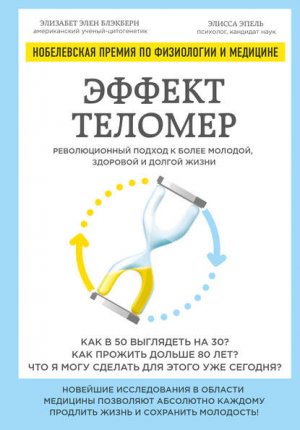Ýôôåêò òåëîìåð: ðåâîëþöèîííûé ïîäõîä ê áîëåå ìîëîäîé, çäîðîâîé è äîëãîé æèçíè Áëýêáåðí Ýëèçàáåò

Ãëàâà 7. Òðåíèðóéòå ñâîè òåëîìåðû: ñêîëüêî óïðàæíåíèé âàì òðåáóåòñÿ?
1. Najarro, K., et al., “Telomere Length as an Indicator of the Robustness of B– and T – Cell Response to Influenza in Older Adults,” Journal of Infectious Diseases 212, no. 8 (October 15, 2015): 1261–1269, doi:10.1093/ infdis/jiv202.
2. Simpson, R. J., et al., “Exercise and the Aging Immune System,” Ageing Research Reviews 11, no. 3 (July 2012): 404–420, doi:10.1016/j.arr.2012.03.003.
3. Cherkas, L. F., et al., “The Association Between Physical Activity in Leisure Time and Leukocyte Telomere Length,” Archives of Internal Medicine 168, no. 2 (January 28, 2008): 154–158, doi:10.1001/archinternmed.2007.39.
4. Loprinzi, P. D., “Leisure-Time Screen-Based Sedentary Behavior and Leukocyte Telomere Length: Implications for a New Leisure-Time Screen-Based Sedentary Behavior Mechanism,” Mayo Clinic Proceedings 90, no. 6 (June 2015): 786–790, doi:10.1016/j.mayocp.2015.02.018; and Sjgren, P., et al., “Stand Up for Health – Avoiding Sedentary Behaviour Might Lengthen Your Telomeres: Secondary Outcomes from a Physical Activity RCT in Older People,” British Journal of Sports Medicine 48, no 19 (October 2014): 1407–1409, doi:10.1136/bjsports-2013–093342.
5. Werner, C. et al., “Differential Effects of Aerobic Endurance, Interval and Strength Endurance Training on Telomerase Activity and Senescence Marker Expression in Circulating Mononuclear Cells,” European Heart Journal 36 (abstract supplement) (August 2015): P2370, http://eur-heartj.oxfordjournals.org/content/ehj/36/suppl_1/163.full.pdf.
6. Loprinzi, P. D., J. P. Loenneke, and E. H. Blackburn, “Movement-Based Behaviors and Leukocyte Telomere Length Among US Adults,” Medicine and Science in Sports and Exercise 47, no. 11 (November 2015): 2347–2352, doi:10.1249/MSS.0000000000000695.
7. Chilton, W. L., et al., “Acute Exercise Leads to Regulation of Telomere-Associated Genes and MicroRNA Expression in Immune Cells,” PLOS ONE 9, no. 4 (2014): e92088, doi:10.1371/journal.pone.0092088.
8. Denham, J., et al., “Increased Expression of Telomere-Regulating Genes in Endurance Athletes with Long Leukocyte Telomeres,” Journal of Applied Physiology (1985) 120, no. 2 (January 15, 2016): 148–158, doi:10.1152/japplphysiol.00587.2015.
9. Rana, K. S., et al., “Plasma Irisin Levels Predict Telomere Length in Healthy Adults,” Age 36, no. 2 (April 2014): 995–1001, doi:10.1007/s11357–014–9620–9.
10. Mooren, F. C., and K. Krger, “Exercise, Auophagy, and Apoptosis,” Progress in Molecular Biology and Translational Science 135 (2015): 407–422, doi:10.1016/bs.pmbts.2015.07.023.
11. Hood, D. A., et al., “Exercise and the Regulation of Mitochondrial Turnover,” Progress in Molecular Biology and Translational Science 135 (2015): 99–127, doi:10.1016/bs.pmbts.2015.07.007.
12. Loprinzi, P. D., “Cardiorespiratory Capacity and Leukocyte Telomere Length Among Adults in the United States,” American Journal of Epidemiology 182, no. 3 (August 1, 2015): 198–201, doi:10.1093/aje/kwv056.
13. Krauss, J., et al., “Physical Fitness and Telomere Length in Patients with Coronary Heart Disease: Findings from the Heart and Soul Study,” PLOS ONE 6, no. 11 (2011): e26983, doi:10.1371/journal.pone.0026983.
14. Denham, J., et al., “Longer Leukocyte Telomeres Are Associated with Ultra-Endurance Exercise Independent of Cardiovascular Risk Factors,” PLOS ONE 8, no.7 (2013): e69377, doi:10.1371/journal.pon e.0069377.
15. Denham et al., “Increased Expression of Telomere-Regulating Genes in Endurance Athletes with Long Leukocyte Telomeres.” (See #8 above.)
16. Laine, M. K., et al., “Effect of Intensive Exercise in Early Adult Life on Telomere Length in Later Life in Men,” Journal of Sports Science and Medicine 14, no. 2 (June 2015):
239–245.
17. Werner, C., et al., “Physical Exercise Prevents Cellular Senescence in Circulating Leukocytes and in the Vessel Wall,” Circulation 120, no. 24 (December 15, 2009): 2438–2447, doi:10.1161/CIRCULATIONAHA.109.861005.
18. Saenroth, D., et al., “Sports and Exercise at Different Ages and Leukocyte Telomere Length in Later Life – Data from the Berlin Aging Study II (BASE-II),” PLOS ONE 10, no. 12 (2015): e0142131, doi:10.1371/ journal.pone.0142131.
19. Collins, M., et al., “Athletes with Exercise-Associated Fatigue Have Abnormally Short Muscle DNA Telomeres,” Medicine and Science in Sports and Exercise 35, no. 9 (September 2003): 1524–1528.
20. Wichers, M., et al., “A Time-Lagged Momentary Assessment Study on Daily Life Physical Activity and Affect,” Health Psychology 31, no. 2 (March 2012): 135–144. doi:10.1037/a0025688.
21. Von Haaren, B., et al., “Does a 20–Week Aerobic Exercise Training Programme Increase Our Capabilities to Buffer Real-Life Stressors? A Randomized, Controlled Trial Using Ambulatory Assessment,” European Journal of Applied Physiology 116, no. 2 (February 2016): 383–394, doi:10.1007/s00421–015–3284–8.
22. Puterman, E., et al., “The Power of Exercise: Buffering the Effect of Chronic Stress on Telomere Length,” PLOS ONE 5, no. 5 (2010): e10837, doi:10.1371/journal.pone.0010837.
23. Puterman, E., et al., “Multisystem Resiliency Moderates the Major Depression – Telomere Length Association: Findings from the Heart and Soul Study,” Brain, Behavior, and Immunity 33 (October 2013): 65–73, doi:10.1016/j.bbi.2013.05.008.
24. Werner et al., “Differential Effects of Aerobic Endurance, Interval and Strength Endurance Training on Telomerase Activity and Senescence Marker Expression in Circulating Mononuclear Cells.” (See #5 above.)
25. Masuki, S., et al., “The Factors Affecting Adherence to a Long-Term Interval Walking Training Program in Middle-Aged and Older People,” Journal of Applied Physiology (1985) 118, no. 5 (March 1, 2015): 595–603, doi:10.1152/japplphysiol.00819.2014.
26. Loprinzi, “Leisure – Time -Screen – Based Sedentary Behavior and Leukocyte Telomere Length.” (See #4 above.)
Ãëàâà 8. Óñòàëûå òåëîìåðû: îò èñòîùåíèÿ ê âîññòàíîâëåíèþ
1. “Lack of Sleep Is Affecting Americans, Finds the National Sleep -Foundation,” National Sleep Foundation, https://sleepfoundation.org/media-center/press-release/lack-sleep-affecting-americans-finds-the-national-sleep-foundation, accessed September 29, 2015.
2. Carroll, J. E., et al., “Insomnia and Telomere Length in Older Adults,” Sleep, 39, no. 3 (March 1, 2016): 559–564, doi:10.5665/sleep.5526.
3. Micic, G., et al., “The Etiology of Delayed Sleep Phase Disorder,” Sleep Medicine Reviews 27 (June 2016): 29–38, doi:10.1016/j.smrv.2015.06.004.
4. Sachdeva, U. M., and C. B. Thompson, “Diurnal Rhythms of Autophagy: Implications for Cell Biology and Human Disease,” Autophagy 4, no. 5 (July 2008): 581–589.
5. Gonnissen, H. K. J., T. Hulshof, and M. S. Westerterp-Plantenga, “Chronobiology, Endocrinology, and Energy-and-Food-Reward Homeostasis,” Obesity Reviews 14, no. 5 (May 2013): 405–416, doi:10.1111/ obr.12019.
6. Van der Helm, E., and M. P. Walker, “Sleep and Emotional Memory Processing,” Journal of Clinical Sleep Medicine 6, no. 1 (March 2011): 31–43.
7. Meerlo, P., A. Sgoifo, and D. Suchecki, “Restricted and Disrupted Sleep: Effects on Autonomic Function, Neuroendocrine Stress Systems and Stress Responsivity,” Sleep Medicine Reviews 12, no. 3 (June 2008): 197–210, doi:10.1016/j.smrv.2007.07.007.
8. Walker, M. P., “Sleep, Memory, and Emotion,” Progress in Brain Research 185 (2010): 49–68, doi:10.1016/B978–0–444–53702–7.00004-X.
9. Lee, K. A., et al., “Telomere Length Is Associated with Sleep Duration but Not Sleep Quality in Adults with Human Immunodeficiency Virus,” Sleep 37, no. 1 (January 1, 2014): 157–166, doi:10.5665/sleep.3328; and Cribbet, M. R., et al., “Cellular Aging and Restorative Processes: Subjective Sleep Quality and Duration Moderate the Association Between Age and Telomere Length in a Sample of Middle-Aged and Older Adults,” Sleep 37, no. 1 (January 1, 2014): 65–70, doi:10.5665/sleep.3308.
10. Jackowska, M., et. al., “Short Sleep Duration Is Associated with Shorter Telomere Length in Healthy Men: Findings from the Whitehall II Cohort Study,” PLOS ONE 7, no. 10 (2012): e47292, doi:10.1371/journal.pone.0047292.
11. Cribbet et al., “Cellular Aging and Restorative Processes.” (See #9 above.)
12. Ibid.
13. Prather, A. A., et al., “Tired Telomeres: Poor Global Sleep Quality, Perceived Stress, and Telomere Length in Immune Cell Subsets in Obese Men and Women,” Brain, Behavior, and Immunity 47 (July 2015): 155–162, doi:10.1016/j.bbi.2014.12.011.
14. Chen, W. D., et al., “The Circadian Rhythm Controls Telomeres and Telomerase Activity,” Biochemical and Biophysical Research Communications 451, no. 3 (August 29, 2014): 408–414, doi:10.1016/j.bbrc.2014.07.138.
15. Ong, J., and D. Sholtes, “A Mindfulness-Based Approach to the Treatment of Insomnia,” Journal of Clinical Psychology 66, no. 11 (November 2010): 1175–1184, doi:10.1002/jclp.20736.
16. Ong, J. C., et al., “A Randomized Controlled Trial of Mindfulness Meditation for Chronic Insomnia,” Sleep 37, no. 9 (September 1, 2014): 1553–1563B, doi:10.5665/sleep.4010.
17. Chang, A. M., D. Aeschbach, J. F. Duffy, C. A. and Czeisler, “Evening Use of Light-Emitting eReaders Negatively Affects Sleep, Circadian Timing, and Next-Morning Alertness,” Proceedings of the National Academy of Sciences of the United States of America 112, no. 4 (January 2015): 1232–1237, doi:10.1073/pnas.1418490112.
18. Dang – Vu, T. T., et al., “Spontaneous Brain Rhythms Predict Sleep Stability in the Face of Noise,” Current Biology 20, no. 15 (August 10, 2010): R626–R627, doi:10.1016/j.cub.2010.06.032.
19. Griefhan, B., P. Brde, A. Marks, and M. Basner, “Autonomic Arousals Related to Traffic Noise During Sleep,” Sleep 31, no. 4 (April 2008): 569–577.
20. Savolainen, K., et al., “The History of Sleep Apnea Is Associated with Shorter Leukocyte Telomere Length: The Helsinki Birth Cohort Study,” Sleep Medicine 15, no. 2 (February 2014): 209–212, doi:10.1016/j.sleep.2013.11.779.
21. Saliu, H. M., et al., “Association Between Maternal Symptoms of Sleep Disordered Breathing and Fetal Telomere Length,” Sleep 38, no. 4 (April 1, 2015): 559–566, doi:10.5665/sleep.4570.
22. Shin, C., C. H. Yun, D. W. Yoon, and I. Baik, “Association Between Snoring and Leukocyte Telomere Length,” Sleep 39, no. 4 (April 1, 2016): 767–772, doi:10.5665/sleep.5624.
Ãëàâà 9. Âåñ è òåëîìåðû: íîðìàëüíûé îáìåí âåùåñòâ
1. Mundstock, E., et al., “Effect of Obesity on Telomere Length: Systematic Review and Meta-analysis,” Obesity (Silver Spring) 23, no. 11 (November 2015): 2165–2174, doi:10.1002/oby.21183.
2. Bosello, O., M. P. Donataccio, and M. Cuzzolaro, “Obesity or Obesities? Controversies on the Association Between Body Mass Index and Premature Mortality,” Eating and Weight Disorders 21, no. 2 (June 2016): 165–174, doi:10.1007/s40519–016–0278–4.
3. Farzaneh-Far, R., et al., “Telomere Length Trajectory and Its Determinants in Persons with Coronary Artery Disease: Longitudinal Findings from the Heart and Soul Study,” PLOS ONE 5, no. 1 (January 2010): e8612, doi:10.1371/journal.pone.0008612.
4. “IDF Diabetes Atlas, Sixth Edition,” International Diabetes Federation, http://www.idf.org/atlasmap/atlasmap?indicator=i1&date=2014, accessed September 16, 2015.
5. Farzaneh-Far et al., “Telomere Length Trajectory and Its Determinants in Persons with Coronary Artery Disease.” (See #3 above.)
6. Verhulst, S., et al., “A Short Leucocyte Telomere Length Is Associated with Development of Insulin Resistance,” Diabetologia 59, no. 6 (June 2016): 1258–1265, doi:10.1007/s00125–016–3915–6.
7. Zhao, J., et al., “Short Leukocyte Telomere Length Predicts Risk of Diabetes in American Indians: The Strong Heart Family Study,” Diabetes 63, no. 1 (January 2014): 354–362, doi:10.2337/db13–0744.
8. Willeit, P., et al., “Leucocyte Telomere Length and Risk of Type 2 Diabetes Mellitus: New Prospective Cohort Study and Literature-Based Meta-analysis.” PLOS ONE 9, no. 11 (2014): e112483, doi:10.1371/journal.pone.0112483.
9. Guo, N., et al., “Short Telomeres Compromise b-Cell Signaling and Survival,” PLOS ONE 6, no. 3 (2011): e17858, doi:10.1371/journal.pone.0017858.
10. Formichi, C., et al., “Weight Loss Associated with Bariatric Surgery Does Not Restore Short Telomere Length of Severe Obese Patients after 1 Year,” Obesity Surgery 24, no.12 (December 2014): 2089–2093, doi:10.1007/s11695–014–1300–4.
11. Gardner, J. P., et al., “Rise in Insulin Resistance is Associated with Escalated Telomere Attrition,” Circulation 111, no. 17 (May 3, 2005): 2171–2177.
12. Fothergill, Erin, Juen Guo, Lilian Howard, Jennifer C. Kerns, Nicolas D. Knuth, Robert Brychta, Kong Y. Chen, et al. “Persistent Metabolic Adaptation Six Years after The Biggest Loser Competition.” Obesity (Silver Spring, Md.), May 2, 2016. doi:10.1002/oby.21538.
13. Kim, S., et al., “Obesity and Weight Gain in Adulthood and Telomere Length,” Cancer Epidemiology, Biomarkers & Prevention 18, no. 3 (March 2009): 816–820, doi:10.1158/1055–9965.EPI-08–0935.
14. Cottone, P., et al., “CRF System Recruitment Mediates Dark Side of Compulsive Eating,” Proceedings of the National Academy of Sciences of the United States of America 106, no. 47 (November 2009): 20016–20020, doi:0.1073/pnas.0908789106.
15. Tomiyama, A. J., et al., “Low Calorie Dieting Increases Cortisol,” Psychosomatic Medicine 72, no. 4 (May 2010): 357–364, doi:10.1097/ PSY.0b013e3181d9523c.
16. Kiefer, A., J. Lin, E. Blackburn, and E. Epel, “Dietary Restraint and Telomere Length in Pre– and Post-Menopausal Women,” Psychosomatic Medicine 70, no. 8 (October 2008): 845–849, doi:10.1097/PSY.0b013 e318187d05e.
17. Hu, F. B., “Resolved: There Is Sufficient Scientific Evidence That Decreasing Sugar-Sweetened Beverage Consumption Will Reduce the Prevalence of Obesity and Obesity-Related Diseases,” Obesity Reviews 14, no. 8 (August 2013): 606–619, doi:10.1111/obr.12040; and Yang, Q., et al., “Added Sugar Intake and Cardiovascular Diseases Mortality Among U.S. Adults,” JAMA Internal Medicine 174, no. 4 (April 2014): 516–524, doi:10.1001/jamainternmed.2013.13563.
18. Schulte, E. M., N. M. Avena, and A. N. Gearhardt, “Which Foods May Be Addictive? The Roles of Processing, Fat Content, and Glycemic Load,” PLOS ONE 10, no. 2 (February 18, 2015): e0117959, doi:10.1371/ journal.pone.0117959.
19. Lustig, R. H. et al., “Isocaloric Fructose Restriction and Metabolic Improvement in Children with Obesity and Metabolic Syndrome,” Obesity 2 (February 24, 2016): 453–60. doi:10.1002/oby.21371. Epub Oct 26, 2015.
20. Incollingo Belsky, A. C., E. S. Epel, and A. J. Tomiyama, “Clues to Maintaining Calorie Restriction? Psychosocial Profiles of Successful Long-Term Restrictors,” Appetite 79 (August 2014): 106–112, doi:10.1016/ j.appet.2014.04.006.
21. Wang, C., et al., “Adult-Onset, Short-Term Dietary Restriction Reduces Cell Senescence in Mice,” Aging 2, no. 9 (September 2010): 555–566.
22. Daubenmier, J., et al., “Changes in Stress, Eating, and Metabolic Factors Are Related to Changes in Telomerase Activity in a Randomized Mindfulness Intervention Pilot Study,” Psychoneuroendocrinology 37, no. 7 (July 2012): 917–928, doi:10.1016/j.psyneuen.2011.10.008.
23. Mason, A. E., et al., “Effects of a Mindfulness-Based Intervention on Mindful Eating, Sweets Consumption, and Fasting Glucose Levels in Obese Adults: Data from the SHINE Randomized Controlled Trial,” Journal of Behavioral Medicine 39, no. 2 (April 2016): 201–213, doi:10.1007/s10865–015–9692–8.
24. Kristeller, J., with A. Bowman, The Joy of Half a Cookie: Using Mindfulness to Lose Weight and End the Struggle with Food (New York: Perigee, 2015). Also see www.mindfuleatingtraining.com and www.mb-eat.com.
Ãëàâà 10. Åäà è òåëîìåðû: êàê ïèòàòüñÿ, ÷òîáû êëåòêè áûëè çäîðîâûìè
1. Jurk, D., et al., “Chronic Inflammation Induces Telomere Dysfunction and Accelerates Ageing in Mice,” Nature Communications 2 (June 24, 2104): 4172, doi:10.1038/ncomms5172.
2. “What You Eat Can Fuel or Cool Inflammation, A Key Driver of Heart Disease, Diabetes, and Other Chronic Conditions,” Harvard Medical School, Harvard Health Publications, http://www.health.harvard.edu/family_health_guide/what-you-eat-can-fuel-or-cool-inflammation-a-key-driver-of-heart-disease-diabetes-and-other-chronic-conditions, accessed November 27, 2015.
3. Weischer, M., S. E. Bojesen, and B. G. Nordestgaard, “Telomere Shortening Unrelated to Smoking, Body Weight, Physical Activity, and Alcohol Intake: 4,576 General Population Individuals with Repeat Measurements 10 Years Apart,” PLOS Genetics 10, no. 3 (March 13, 2014): e1004191, doi:10.1371/journal.pgen.1004191; and Pavanello, S., et al., “Shortened Telomeres in Individuals with Abuse in Alcohol Consumption,” International Journal of Cancer 129, no. 4 (August 15, 2011): 983–992. doi:10.1002/ijc.25999.
4. Cassidy, A., et al., “Higher Dietary Anthocyanin and Flavonol Intakes Are Associated with Anti-inflammatory Effects in a Population of U.S. Adults,” American Journal of Clinical Nutrition 102, no. 1 (July 2015): 172–181, doi:10.3945/ajcn.115.108555.
5. Farzaneh-Far, R., et al., “Association of Marine Omega–3 Fatty Acid Levels with Telomeric Aging in Patients with Coronary Heart Disease,” JAMA 303, no. 3 (January 20, 2010): 250–257, doi:10.1001/jama.2009.2008.
6. Goglin, S., et al., “Leukocyte Telomere Shortening and Mortality in Patients with Stable Coronary Heart Disease from the Heart and Soul Study,” 2016, in press, PLOS ONE.
7. Farzaneh-Far et al., “Association of Marine Omega–3 Fatty Acid Levels with Telomeric Aging in Patients with Coronary Heart Disease.” (See #5 above.)
8. Kiecolt-Glaser, J. K., et. al., “Omega–3 Fatty Acids, Oxidative Stress, and Leukocyte Telomere Length: A Randomized Controlled Trial,” Brain, Behavior, and Immunity 28 (February 2013): 16–24, doi:10.1016/j. bbi.2012.09.004.
9. Glei, D. A., et al., “Shorter Ends, Faster End? Leukocyte Telomere Length and Mortality Among Older Taiwanese,” Journals of Gerontology, Series A: Biological Sciences and Medical Sciences 70, no. 12 (December 2015): 1490–1498, doi:10.1093/gerona/glu191.
10. Debreceni, B., and L. Debreceni, “The Role of Homocysteine-Lowering B – Vitamins in the Primary Prevention of Cardiovascular Disease,” Cardiovascular Therapeutics 32, no. 3 (June 2014): 130–138, doi:10.1111/1755–5922.12064.
11. Kawanishi, S., and S. Oikawa, “Mechanism of Telomere Shortening by Oxidative Stress,” Annals of the New York Academy of Sciences 1019 (June 2004): 278–284.
12. Haendeler, J., et al., “Hydrogen Peroxide Triggers Nuclear Export of Telomerase Reverse Transcriptase via Src Kinase Familiy-Dependent Phosphorylation of Tyrosine 707,” Molecular and Cellular Biology 23, no. 13 (July 2003): 4598–4610.
13. Adelfalk, C., et al., “Accelerated Telomere Shortening in Fanconi Anemia Fibroblasts – a Longitudinal Study,” FEBS Letters 506, no. 1 (September 28, 2001): 22–26.
14. Xu Q. et al., “Multivitamin Use and Telomere Length in Women,” American Journal of Clinical Nutrition 89 (6) (June 2009): 1857–63, doi:10.3945/ ajcn.2008.26986. epub Mar 11, 2009.
15. Paul, L., et al., “High Plasma Folate Is Negatively Associated with Leukocyte Telomere Length in Framingham Offspring Cohort,” European Journal of Nutrition 54, no. 2 (March 2015): 235–241, doi:10.1007/ s00394–014–0704–1.
16. Wojcicki, Janet et al “Early Exclusive Breastfeeding Is Associated with Longer Telomeres in Latino Preschool Children.” The American Journal of Clinical Nutrition, July 20, 2016. doi:10.3945/ajcn.115.115428.
17. Leung, C. W., et al., “Soda and Cell Aging: Associations Between Sugar-Sweetened Beverage Consumption and Leukocyte Telomere Length in Healthy Adults from the National Health and Nutrition Examination Surveys,” American Journal of Public Health, 104, no. 12 (December 2014): 2425–2431, doi:10.2105/AJPH.2014.302151.
18. Wojcicki, Janet M., et al “Early Exclusive Breastfeeding Is Associated with Longer Telomeres in Latino Preschool Children.” The American Journal of Clinical Nutrition, July 20, 2016.doi:10.3945/ajcn.115.115428.
19. “Peppermint Mocha,” Starbucks, http://www.starbucks.com/menu/drinks/ espresso/peppermint-mocha#size=179560&milk=63&whip=125, accessed September 29, 2015.
20. Pilz, Stefan, Martin Grbler, Martin Gaksch, Verena Schwetz, Christian Trummer, Brain Hartaigh, Nicolas Verheyen, Andreas Tomaschitz, and Winfried Mrz. “Vitamin D and Mortality.” Anticancer Research 36, no. 3 (March 2016): 1379–87.
21. Zhu et al., “Increased Telomerase Activity and Vitamin D Supplementation in Overweight African Americans,” International Journal of Obesity (June 2012): 805–09, doi:10.1038/ijo.2011.197.
22. Boccardi, V., et al., “Mediterranean Diet, Telomere Maintenance and Health Status Among Elderly,” PLOS ONE 8, no.4 (April 30, 2013): e62781, doi:10.1371/journal.pone.0062781.
23. Lee, J. Y., et al., “Association Between Dietary Patterns in the Remote Past and Telomere Length,” European Journal of Clinical Nutrition 69, no. 9 (September 2015): 1048–1052, doi:10.1038/ejcn.2015.58.
24. Ibid.
25. “IARC Monographs Evaluate Consumption of Red Meat and Processed Meat,” World Health Organization, International Agency for Research on Cancer, press release, October 26, 2015, https://www.iarc.fr/en/media-centre/pr/2015/pdfs/pr240_E.pdf.
26. Nettleton, J. A., et al., “Dietary Patterns, Food Groups, and Telomere Length in the Multi-Ethnic Study of Atherosclerosis (MESA),” American Journal of Clinical Nutrition 88, no. 5 (November 2008): 1405–1412.
27. Cardin, R., et al., “Effects of Coffee Consumption in Chronic Hepatitis C: A Randomized Controlled Trial,” Digestive and Liver Disease 45, no. 6 (June 2013): 499–504, doi:10.1016/j.dld.2012.10.021.
28. Liu JJ, Crous-Bou M, Giovannucci E, De Vivo I.“Coffee Consumption Is Positively Associated with Longer Leukocyte Telomere Length” in the Nurses’ Health Study. J Nutr. 2016 Jul;146 (7):1373–8. doi: 10.3945/ jn.116.230490. Epub 2016 Jun 8.
29. Lee, J. Y., et al., “Association Between Dietary Patterns in the Remote Past and Telomere Length.” (See #23 above.) Nettleton et al., “Dietary Patterns, Food Groups, and Telomere Length in the Multi-Ethnic Study of Atherosclerosis (MESA).”
30. Garca-Calzn, S., et al., “Telomere Length as a Biomarker for Adiposity Changes After a Multidisciplinary Intervention in Overweight/Obese Adolescents: The EVASYON Study,” PLOS ONE 9, no. 2 (February 24, 2014): e89828, doi:10.1371/journal.pone.0089828.
31. Lee et al., “Association Between Dietary Patterns in the Remote Past and Telomere Length.” (See #23 above.)
32. Leung et al., “Soda and Cell Aging.” (See #17 above.)
33. Tiainen, A. M., et al., “Leukocyte Telomere Length and Its Relation to Food and Nutrient Intake in an Elderly Population,” European Journal of Clinical Nutrition 66, no. 12 (December 2012): 1290–1294, doi:10.1038/ejcn.2012.143.
34. Cassidy, A., et al., “Associations Between Diet, Lifestyle Factors, and Telomere Length in Women,” American Journal of Clinical Nutrition 91, no. 5 (May 2010): 1273–1280, doi:10.3945/ajcn.2009.28947.
35. Pavanello et al., “Shortened Telomeres in Individuals with Abuse in Alcohol Consumption.” (See #13 above.)
36. Cassidy et al., “Associations Between Diet, Lifestyle Factors, and Telomere Length in Women.” (See #34 above.)
37. Tiainen et al., “Leukocyte Telomere Length and Its Relation to Food and Nutrient Intake in an Elderly Population.” (See #33 above.)
38. Lee et al., “Association Between Dietary Patterns in the Remote Past and Telomere Length.” (See #23 above.)
39. Ibid.
40. Ibid.
41. Farzaneh-Far et al., “Association of Marine Omega–3 Fatty Acid Levels With Telomeric Aging in Patients With Coronary Heart Disease.” (See #25 above.)
42. Garca-Calzn et al., “Telomere Length as a Biomarker for Adiposity Changes After a Multidisciplinary Intervention in Overweight/Obese Adolescents: The EVASYON Study.” (See #30 above.)
43. Liu JJ, Crous-Bou M, Giovannucci E, De Vivo I. “Coffee Consumption Is Positively Associated with Longer Leukocyte Telomere Length” in the Nurses’ Health Study. J Nutr. 2016 Jul;146 (7):1373–8. doi: 10.3945/ jn.116.230490. Epub 2016 Jun 8. PMID: 27281805.
44. Paul, L., “Diet, Nutrition and Telomere Length,” Journal of Nutritional Biochemistry 22, no. 10 (October 2011): 895–901, doi:10.1016/ j.jnutbio.2010.12.001.
45. Richards, J. B., et al., “Higher Serum Vitamin D Concentrations Are Associated with Longer Leukocyte Telomere Length in Women,” American Journal of Clinical Nutrition 86, no. 5 (November 2007): 1420–1425. Xu et al., “Multivitamin Use and Telomere Length in Women.” (See #14 above.)
46. Paul et al., “High Plasma Folate Is Negatively Associated with Leukocyte Telomere Length in Framingham Offspring Cohort.” (This study also found vitamin use was associated with shorter telomeres.) (See #15 above.)
47. O’Neill, J., T. O. Daniel, and L. H. Epstein, “Episodic Future Thinking Reduces Eating in a Food Court,” Eating Behaviors 20 (January 2016): 9–13, doi:10.1016/j.eatbeh.2015.10.002.
Ñîâåòû ñïåöèàëèñòîâ ïî îìîëîæåíèþ. Êàê ðàç è íàâñåãäà èçìåíèòü æèçíü ê ëó÷øåìó
48. Vasilaki, E. I., S. G. Hosier, and W. M. Cox, “The Efficacy of Motivational Interviewing as a Brief Intervention for Excessive Drinking: A Mea-analytic Review.” Alcohol and Alcoholism 41, no. 3 (May 2006): 328–335, doi:10.1093/ alcalc/agl016; and Lindson-Hawley, N., T. P. Thompson, and R. Begh, “Motivational Interviewing for Smoking Cessation,” Cochrane Database of Systematic Reviews 3 (March 2, 2015): CD006936, doi:10.1002/14651858.CD006936.pub3.
49. Sheldon, K. M., A. Gunz, C. P. Nichols, and Y. Ferguson, “Extrinsic Value Orientation and Affective Forecasting: Overestimating the Rewards, Under-estimating the Costs,” Journal of Personality 78, no. 1 (February 2010): 149–178, doi:10.1111/j.1467–6494.2009.00612.x; Kasser, T., and R. M. Ryan, “Further Examining the American Dream: Differential Correlates of Intrinsic and Extrinsic Goals,” Personality– and Social Psychology Bulletin 22, no. 3 (March 1996): –280–287, doi:10.1177/0146167296223006; and Ng, J. Y., et al., “Self-Determination Theory Applied to Health Contexts: A Meta-analysis,” Perspectives on Psychological Science: A Journal of the Association for Psychological Science 7, no. 4 (July 2012): 325–340, doi:10.1177/1745691612447309.
50. Ogedegbe, G. O., et al., “A Randomized Controlled Trial of Positive-Affect Intervention and Medication Adherence in Hypertensive African Americans,” Archives of Internal Medicine 172, no. 4 (February 27, 2012): 322–326, doi:10.1001/archinternmed.2011.1307.
51. Bandura, A., “Self-Efficacy: Toward a Unifying Theory of Behavioral Change.” Psychological Review 84, no. 2 (March 1977): 191–215.
52. B. J. Fogg illustrates his suggestion of making tiny changes attached to daily trigger events: “Forget Big Change, Start with a Tiny Habit: BJ Fogg at TEDxFremont,” YouTube, https://www.youtube.com/watch?v=AdKU Jxjn-R8.
53. Baumeister, R. F., “Self-Regulation, Ego Depletion, and Inhibition,” Neuropsychologia 65 (December 2014): 313–319, doi:10.1016/j.neuropsycho logia.2014.08.012.
Ãëàâà 11. Ëþäè è ìåñòà, áëàãîïðèÿòíûå äëÿ òåëîìåð
1. Needham, B. L., et al., “Neighborhood Characteristics and Leukocyte Telomere Length: The Multi-Ethnic Study of Atherosclerosis,” Health & Place 28 (July 2014): 167–172, doi:10.1016/j.healthplace.2014.04.009.
2. Geronimus, A. T., et al., “Race-Ethnicity, Poverty, Urban Stressors, and Telomere Length in a Detroit Community-Based Sample,” Journal of Health and Social Behavior 56, no. 2 (June 2015): 199–224, doi:10.1177/0022146515582100.
3. Park, M., et al., “Where You Live May Make You Old: The Association Between Perceived Poor Neighborhood Quality and Leukocyte Telomere Length,” PLOS ONE 10, no. 6 (June 17, 2015): e0128460, doi:10.1371/journal.pone.0128460.
4. Ibid.
5. Lederbogen, F., et al., “City Living and Urban Upbringing Affect Neural Social Stress Processing in Humans,” Nature 474, no. 7352 (June 22, 2011): 498–501, doi:10.1038/nature10190.
6. Park et al., “Where You Live May Make You Old.” (See #3 above.)
7. DeSantis, A. S., et al., “Associations of Neighborhood Characteristics with Sleep Timing and Quality: The Multi-Ethnic Study of Atherosclerosis,” Sleep 36, no. 10 (October 1, 2013): 1543–1551, doi:10.5665/sleep.3054.
8. Theall, K. P., et al., “Neighborhood Disorder and Telomeres: Connecting Children’s Exposure to Community Level Stress and Cellular Response,” Social Science & Medicine (1982) 85 (May 2013): 50–58. doi:10.1016/j.socscimed.2013.02.030.
9. Woo, J., et al., “Green Space, Psychological Restoration, and Telomere Length,” Lancet 373, no. 9660 (January 24, 2009): –299–300, doi:10.1016/S0140–6736 (09) 60094–5.
10. Roe, J. J., et al., ““Green Space and Stress: Evidence from Cortisol Measures in Deprived Urban Communities,” International Journal of Environ-mental Research and Public Health 10, no. 9 (September 2013): 4086–4103, doi:10.3390/ijerph10094086.
11. Mitchell, R., and F. Popham, “Effect of Exposure to Natural Environment on Health Inequalities: An Observational Population Study,” Lancet 372, no. 9650 (November 8, 2008): 1655-1560, doi:10.1016/ S0140–6736 (08) 61689-X.
12. Theall et al., “Neighborhood Disorder and Telomeres.” (See #8 above.)
13. Robertson, T., et al., “Is Socioeconomic Status Associated with Biological Aging as Measured by Telomere Length?” Epidemiologic Reviews 35 (2013): 98–111, doi:10.1093/epirev/mxs001.
14. Adler, N. E., et al., “Socioeconomic Status and Health. The Challenge of the Gradient,” American Psychologist 49, no. 1 (January 1994): 15–24.
15. Cherkas, L. F., et al., “The Effects of Social Status on Biological Aging as Measured by White-Blood-Cell Telomere Length,” Aging Cell 5, no. 5 (October 2006): 361–365, doi:10.1111/j.1474–9726.2006.00222.x.
16. “Canary Used for Testing for Carbon Monoxide,” Center for Construction Research and Training, Electronic Library of Construction Occupational Safety & Health, http://elcosh.org/video/3801/a000096/canary-used-for-testing-for-carbon-monoxide.html.
17. Hou, L., et al., “Lifetime Pesticide Use and Telomere Shortening Among Male Pesticide Applicators in the Agricultural Health Study,” Environ-mental Health Perspectives 121, no. 8 (August 2013): 919–924, doi:10.1289/ ehp.1206432.
18. Kahl, V. F., et al., “Telomere Measurement in Individuals Occupation-ally Exposed to Pesticide Mixtures in Tobacco Fields,” Environmental and Molecular Mutagenesis 57, no. 1 (January 2016), doi:10.1002/em.21984.
19. Ibid.
20. Zota A. R., et al., “Associations of Cadmium and Lead Exposure with Leukocyte Telomere Length: Findings from National Health and Nutrition Examination Survey, 1999–2002,” American Journal of Epidemiology 181, no. 2 (January 15, 2015): –127–136, doi:10.1093/aje/kwu293.
21. “Toxicological Profile for Cadmium,” U.S. Department of Health and Human Services, Public Health Service, Agency for Toxic Substances and Disease Registry (Atlanta, GA, September 2012), http://www.atsdr.cdc.gov/toxprofiles/tp5.pdf.
22. Lin, S., et al., “Short Placental Telomere Was Associated with Cadmium Pollution in an Electronic Waste Recycling Town in China,” PLOS ONE 8, no. 4 (2013): e60815, doi:10.1371/journal.pone.0060815.
23. Zota et al., “Associations of Cadmium and Lead Exposure with Leukocyte Telomere Length.” (See #20 above.)
24. Wu, Y., et al., “High Lead Exposure Is Associated with Telomere Length Shortening in Chinese Battery Manufacturing Plant Workers,” Occupational and Environmental Medicine 69, no. 8 (August 2012): 557-563, doi:10.1136/oemed-2011–100478.
25. Ibid.
26. Pawlas, N., et al., “Telomere Length in Children Environmentally Exposed to Low-to-Moderate Levels of Lead,” Toxicology and Applied Pharmacology 287, no. 2 (September 1, 2015): 111–118, doi:10.1016/j.taap.2015.05.005.
27. Hoxha, M., et al., “Association Between Leukocyte Telomere Shortening and Exposure to Traffic Pollution: A Cross-Sectional Study on Traffic Officers and Indoor Office Workers,” Environmental Health 8 (2009): 41, doi:10.1186/1476–069X-8–41; Zhang, X., S. Lin, W. E. Funk, and L. Hou, “Environmental and Occupational Exposure to Chemicals and Telomere Length in Human Studies,” Postgraduate Medical Journal 89, no. 1058 (December 2013): 722–728, doi:10.1136/postgradmedj– 2012–101350rep; and Mitro, S. D., L. S. Birnbaum, B. L. Needham, and A. R. Zota, “Cross-Sectional Associations Between Exposure to Persistent Organic Pollutants and Leukocyte Telomere Length Among U.S. Adults in NHANES, 2001–2002,” Environmental Health Perspectives 124, no. 5 (May 2016): 651–658, doi:10.1289/ehp.1510187.
28. Bijnens, E., et al., “Lower Placental Telomere Length May Be Attributed to Maternal Residental Traffic Exposure; A Twin Study,” Environment International 79 (June 2015): 1–7, doi:0.1016/j.envint.2015.02.008.
29. Ferrario, D., et al., “Arsenic Induces Telomerase Expression and Maintains Telomere Length in Human Cord Blood Cells,” Toxicology 260, nos. 1–3 (June 16, 2009): 132–141, doi:10.1016/j.tox.2009.03.019; Hou, L., et al., “Air Pollution Exposure and Telomere Length in Highly Exposed Subjects in Beijing, China: A Repeated-Measure Study,” Environment International 48 (November 1, 2012): 71–77, doi:10.1016/j.envint.2012.06.020; Zhang et al., “Environmental and Occupational Exposure to Chemicals and Telomere Length in Human Studies”; Bassig, B. A., et al., “Alterations in Leukocyte Telomere Length in Workers Occupationally Exposed to Benzene,” Environmental and Molecular Mutagenesis 55, no. 8 (2014): 673–678, doi:10.1002/em.21880; and Li, H., K. Engstrm, M. Vahter, and K. Broberg, “Arsenic Exposure Through Drinking Water Is Associated with Longer Telomeres in Peripheral Blood,” Chemical Research in Toxicology 25, no. 11 (November 19, 2012): 2333–2339, doi:10.1021/tx300222t.
30. American Association for Cancer Research, “AACR Cancer Progress Report 2014: Transforming Lives Through Cancer Research,” 2014, http://cancerprogressreport.org/2014/Documents/AACR_CPR_2014.pdf, accessed October 21, 2015.
31. “Cancer Fact Sheet No. 297,” World Health Organization, updated February 2015, http://www.who.int/mediacentre/factsheets/fs297/en/, accessed October 21, 2015.
32. House, J. S., K. R. Landis, and D. Umberson, “Social Relationships and Health,” Science 241, no. 4865 (July 29, 1988): 540–545; Berkman, L. F., and S. L. Syme, “Social Networks, Host Resistance, and Mortality: A Nine-Year Follow-up Study of Alameda County Residents,” American Journal of Epidemiology 109, no. 2 (February 1979): 186–204; and Holt-Lunstad, J., T. B. Smith, M. B. Baker, T. Harris, and D. Stephenson, “Loneliness and Social Isolation as Risk Factors for Mortality: A Meta-analytic Review,” Perspectives on Psychological Science: A Journal of the Association for Psychological Science 10, no. 2 (March 2015): 227–237, doi:10.1177/1745691614568352.
33. Hermes, G. L., et al., “Social Isolation Dysregulates Endocrine and Behavioral Stress While Increasing Malignant Burden of Spontaneous Mammary Tumors,” Proceedings of the National Academy of Sciences of the United States of America 106, no. 52 (December 29, 2009): 22393–22398, doi:10.1073/pnas.0910753106.
34. Aydinonat, D., et al., “Social Isolation Shortens Telomeres in African Grey Parrots (Psittacus erithacus erithacus),” PLOS ONE 9, no. 4 (2014): e93839, doi:10.1371/journal.pone.0093839.
35. Carroll, J. E., A. V. Diez Roux, A. L. Fitzpatrick, and T. Seeman, “Low Social Support Is Associated with Shorter Leukocyte Telomere Length in Late Life: Multi-Ethnic Study of Atherosclerosis,” Psychosomatic Medicine 75, no. 2 (February 2013): 171–77, doi:10.1097/PSY.0b013e31828233bf.
36. Uchino, B. N., et al., “The Strength of Family Ties: Perceptions of Net-work Relationship Quality and Levels of C – Reactive Proteins in the North Texas Heart Study,” Annals of Behavioral Medicine 49, no. 5 (October 2015): 776–781, doi:10.1007/s12160–015–9699-y.
37. Uchino, B. N., et al., “Social Relationships and Health: Is Feeling Positive, Negative, or Both (Ambivalent) About Your Social Ties Related to Telomeres?” Health Psychology 31, no. 6 (November 2012): 789–796, doi:10.1037/a0026836.
38. Robles, T. F., R. B. Slatcher, J. M. Trombello, and M. M. McGinn, “Marital Quality and Health: A Meta-analytic Review,” Psychological Bulletin 140, no. 1 (January 2014): 140–187, doi:10.1037/a0031859.
39. Ibid.
40. Mainous, A. G., et al., “Leukocyte Telomere Length and Marital Status among Middle-Aged Adults,” Age and Ageing 40, no. 1 (January 2011): 73–78, doi:10.1093/ageing/afq118; and Yen, Y., and F. Lung, “Older Adults with Higher Income or Marriage Have Longer Telomeres,” Age and Ageing 42, no. 2 (March 2013): 234–239, doi:10.1093/ageing/afs122.
41. Broer, L., V. Codd, D. R. Nyholt, et al, “Meta-Analysis of Telomere Length in 19,713 Subjects Reveals High Heritability, Stronger Maternal Inheritance and a Paternal Age Effect,” European Journal of Human Genetics: EJHG 21, no. 10 (October 2013): 1163–68, doi:10.1038/ejhg.2012.303.
42. Herbenick, D., et al., “Sexual Behavior in the United States: Results from a National Probability Sample of Men and Women Ages 14–94,” Journal of Sexual Medicine 7, Suppl. 5 (October 7, 2010): 255–265, doi:10.1111/j.1743–6109.2010.02012.x.
43. Saxbe, D. E., et al., “Cortisol Covariation Within Parents of Young Chil-dren: Moderation by Relationship Aggression,” Psychoneuroendocrinology 62 (December 2015): –121–128, doi:10.1016/j.psyneuen.2015.08.006.
44. Liu, S., M. J. Rovine, L. C. Klein, and D. M. Almeida, “Synchrony of Diurnal Cortisol Pattern in Couples,” Journal of Family Psychology 27, no. 4 (August 2013): 579–588, doi:10.1037/a0033735.
45. Helm, J. L., D. A. Sbarra, and E. Ferrer, “Coregulation of Respiratory Sinus Arrhythmia in Adult Romantic Partners,” Emotion 14, no. 3 (June 2014): 522–531, doi:10.1037/a0035960.
46. Hack, T., S. A. Goodwin, and S. T. Fiske, “Warmth Trumps Competence in Evaluations of Both Ingroup and Outgroup,” International Journal of Science, Commerce and Humanities 1, no. 6 (September 2013): 99–105.
47. Parrish, T., “How Hate Took Hold of Me,” Daily News, June 21, 2015, http://www.nydailynews.com/opinion/tim-parrish-hate-hold-article-1.2264643, accessed October 23, 2015.
48. Lui, S. Y., and Kawachi, I. “Discrimination and Telomere Length Among Older Adults in the US: Does the Association Vary by Race and Type of Discrimination?” under review, Public Health Reports.
49. Chae, D. H., et al., “Discrimination, Racial Bias, and Telomere Length in African American Men,” American Journal of Preventive Medicine 46, no. 2 (February 2014): 103–111, doi:10.1016/j.amepre.2013.10.020.
50. Peckham, M., “This Billboard Sucks Pollution from the Sky and Returns Purified Air,” Time, May 1, 2014, http://time.com/84013/this-billboard-sucks-pollution-from-the-sky-and-returns-purified-air/, accessed November 24, 2015.
51. Diers, J., Neighbor Power: Building Community the Seattle Way (Seattle: University of Washington Press, 2004).
52. Beyer, K. M. M., et al., “Exposure to Neighborhood Green Space and Mental Health: Evidence from the Survey of the Health of Wisconsin,” International Journal of Environmental Research and Public Health 11, no. 3 (March 2014): 3453–3472, doi:10.3390/ijerph110303453; and Roe et al., “Green Space and Stress.”
53. Branas, C. C., et al., “A Difference – in – Differences Analysis of Health, Safety, and Greening Vacant Urban Space,” American Journal of Epide-miology 174, no. 11 (December 1, 2011): 1296–1306, doi:10.1093/aje/ kwr273.
54. Wesselmann, E. D., F. D. Cardoso, S. Slater, and K. D. Williams, “To Be Looked At as Though Air: Civil Attention Matters,” Psychological Science 23, no. 2 (February 2012): 166–168, doi:10.1177/0956797611427921.
55. Guguen, N., and M – A De Gail, “The Effect of Smiling on Helping Behavior: Smiling and Good Samaritan Behavior,” 2003., Communication Reports, 16:2, 133–140, DOI: 10.1080/08934210309384496.
Ãëàâà 12. Áåðåìåííîñòü: êëåòî÷íîå ñòàðåíèå íà÷èíàåòñÿ åùå â óòðîáå
1. Hjelmborg, J. B., et al., “The Heritability of Leucocyte Telomere Length Dynamics,” Journal of Medical Genetics 52, no. 5 (May 2015): 297–302, doi:10.1136/jmedgenet-2014–102736.
2. Wojcicki, J. M., et al., “Cord Blood Telomere Length in Latino Infants: Relation with Maternal Education and Infant Sex,” Journal of Perinatology: Official Journal of the California Perinatal Association 36, no. 3 (March 2016): 235–241, doi:10.1038/jp.2015.178.
3. Needham, B. L., et al., “Socioeconomic Status and Cell Aging in Children,” Scial Science and Medicine (1982) 74, no. 12 (June 2012): 1948–1951, doi:10.1016/j.socscimed.2012.02.019.
4. Collopy, L. C., et al., “Triallelic and Epigenetic-Like Inheritance in Human Disorders of Telomerase,” Blood 126, no. 2 (July 9, 2015): 176–184, doi:10.1182/blood-2015–03–633388.
5. Factor-Litvak, P., et al., “Leukocyte Telomere Length in Newborns: Implications for the Role of Telomeres in Human Disease,” Pediatrics 137, no. 4 (April 2016): e20153927, doi:10.1542/peds.2015–3927.
6. De Meyer, T., et al., “A Non-Genetic, Epigenetic-Like Mechanism of Telomere Length Inheritance?” European Journal of Human Genetics 22, no. 1 (January 2014):10–11, doi:10.1038/ejhg.2013.255.
7. Collopy et al., “Triallelic and Epigenetic-like Inheritance in Human Disorders of Telomerase.” (See #4 above.)
8. Tarry-Adkins, J. L., et al., “Maternal Diet Influences DNA Damage, Aortic Telomere Length, Oxidative Stress, and Antioxidant Defense Capacity in Rats,” FASEB Journal: Official Publication of the Federation of American Societies for Experimental Biology 22, no. 6 (June 2008): 2037–2044, doi:10.1096/fj.07–099523.
9. Aiken, C. E., J. L. Tarry-Adkins, and S. E. Ozanne, “Suboptimal Nutrition in Utero Causes DNA Damage and Accelerated Aging of the Female Reproductive Tract,” FASEB Journal: Official Publication of the Federation of American Societies for Experimental Biology 27, no. 10 (October 2013): 3959–3965, doi:10.1096/fj.13–234484.
10. Aiken, C. E., J. L. Tarry-Adkins, and S. E. Ozanne. “Transgenerational Developmental Programming of Ovarian Reserve,” Scientific Reports 5 (2015): 16175, doi:10.1038/srep16175.
11. Tarry-Adkins, J. L., et al., “Nutritional Programming of Coenzyme Q: Potential for Prevention and Intervention?” FASEB Journal: Official Publication of the Federation of American Societies for Experimental Biology 28, no. 12 (December 2014): 5398–5405, doi:10.1096/fj.14–259473.
12. Bull, C., H. Christensen, and M. Fenech, “Cortisol Is Not Associated with Telomere Shortening or Chromosomal Instability in Human Lymphocytes Cultured Under Low and High Folate Conditions,” PLOS ONE 10, no. 3 (March 6, 2015): e0119367, doi:10.1371/journal.pone.0119367; and Bull, C., et al., “Folate Deficiency Induces Dysfunctional Long and Short Telomeres; Both States Are Associated with Hypomethylation and DNA Damage in Human WIL2-NS Cells,” Cancer Prevention Research (Philadelphia, Pa.) 7, no. 1 (January 2014): 128–138, doi:10.1158/1940–6207.CAPR-13–0264.






